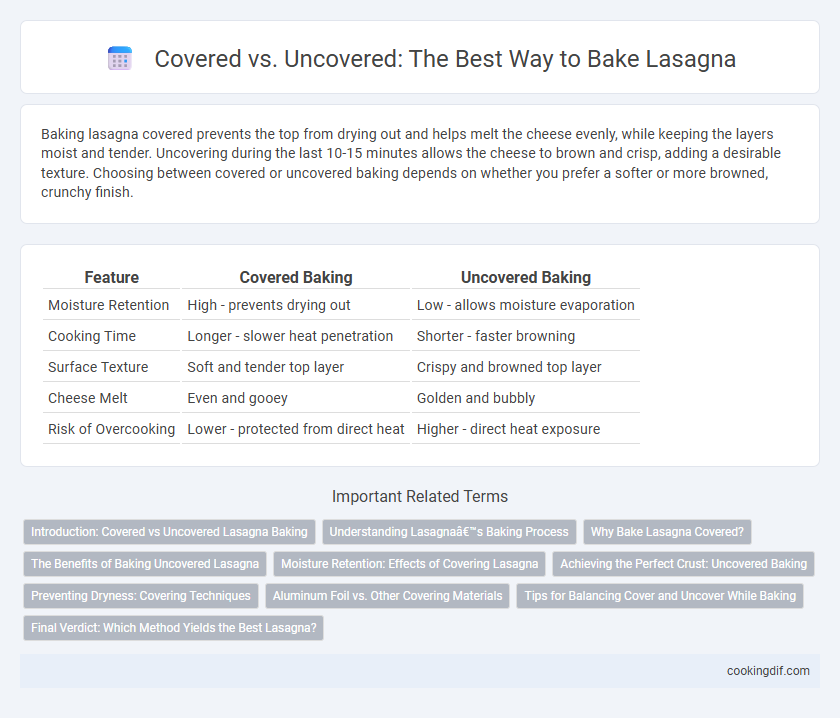Baking lasagna covered prevents the top from drying out and helps melt the cheese evenly, while keeping the layers moist and tender. Uncovering during the last 10-15 minutes allows the cheese to brown and crisp, adding a desirable texture. Choosing between covered or uncovered baking depends on whether you prefer a softer or more browned, crunchy finish.
Table of Comparison
| Feature | Covered Baking | Uncovered Baking |
|---|---|---|
| Moisture Retention | High - prevents drying out | Low - allows moisture evaporation |
| Cooking Time | Longer - slower heat penetration | Shorter - faster browning |
| Surface Texture | Soft and tender top layer | Crispy and browned top layer |
| Cheese Melt | Even and gooey | Golden and bubbly |
| Risk of Overcooking | Lower - protected from direct heat | Higher - direct heat exposure |
Introduction: Covered vs Uncovered Lasagna Baking
Baking lasagna covered with foil traps steam, ensuring even cooking and preventing the top from drying out while keeping the cheese melted and moist. Uncovered lasagna develops a browned, crispy cheese crust and allows excess moisture to evaporate, intensifying flavor and texture. Choosing between covered or uncovered baking depends on desired texture and cooking time, with many recipes recommending removing the cover in the last 15 minutes for a perfect balance.
Understanding Lasagna’s Baking Process
Baking lasagna covered with foil retains moisture, ensuring tender noodles and preventing the top layer from drying out or burning during the initial cooking phase. Uncovered baking allows the cheese to brown and crisp, creating a flavorful, golden crust that enhances texture and presentation. Balancing covered and uncovered baking time is essential to achieving a perfectly cooked, moist interior with a caramelized, appetizing top layer.
Why Bake Lasagna Covered?
Baking lasagna covered with foil helps retain moisture and prevents the pasta from drying out, ensuring a tender texture. The cover traps steam, allowing the cheese to melt evenly and the flavors to meld together while avoiding excessive browning on top. Removing the cover near the end promotes a golden, bubbling crust without sacrificing the dish's overall succulence.
The Benefits of Baking Uncovered Lasagna
Baking lasagna uncovered promotes a golden, crispy cheese topping and prevents excess moisture buildup, ensuring a firm, well-set texture. This method enhances caramelization, intensifying flavors and creating a desirable crust. Uncovered lasagna also allows steam to escape, preventing sogginess and preserving the ideal balance between sauce and pasta layers.
Moisture Retention: Effects of Covering Lasagna
Covering lasagna during baking traps steam, significantly enhancing moisture retention and preventing the pasta layers from drying out. Uncovered baking allows excess moisture to evaporate, resulting in a firmer texture but a risk of a dry, crusty top layer. Optimal baking often involves starting covered to maintain moisture and finishing uncovered for a golden, crisp surface.
Achieving the Perfect Crust: Uncovered Baking
Baking lasagna uncovered allows the top layer of cheese and sauce to develop a golden, crispy crust that enhances texture and flavor complexity. Covering lasagna with foil traps moisture, preventing the Maillard reaction essential for browning and resulting in a softer, less caramelized surface. For achieving the perfect crust, leaving the lasagna uncovered during the last 15-20 minutes of baking maximizes browning without drying out the dish.
Preventing Dryness: Covering Techniques
Covering lasagna during baking with foil or a lid traps steam, preserving moisture and preventing the dish from drying out. Removing the cover during the last 10-15 minutes allows the top layer to brown and develop a crispy texture without sacrificing overall moisture. Using a combination of covered and uncovered baking optimizes both tenderness and flavorful crust formation.
Aluminum Foil vs. Other Covering Materials
When baking lasagna, covering with aluminum foil helps retain moisture and ensures even cooking while preventing the top from burning. Alternatives such as parchment paper or silicone lids offer breathability and reduce condensation but may not trap heat as effectively as foil. Choosing the right covering material affects the texture and finish, with foil ideal for longer bakes and uncovered methods promoting a crispier top layer.
Tips for Balancing Cover and Uncover While Baking
Covering lasagna with foil during the initial baking phase traps moisture, ensuring the pasta cooks evenly without drying out, while uncovering it in the last 10-15 minutes promotes a golden, bubbly cheese topping. Using a light layer of oil or butter on the foil prevents sticking and allows easy removal, preserving the dish's presentation. Balancing covered and uncovered baking times optimizes texture and flavor, resulting in a moist, perfectly browned lasagna.
Final Verdict: Which Method Yields the Best Lasagna?
Baking lasagna covered retains moisture, resulting in a tender texture and evenly melted cheese, while uncovered baking creates a golden, slightly crispy top layer that enhances flavor complexity. The best method depends on desired texture: cover for a soft, cohesive dish or uncover near the end for a browned, bubbly finish. Combining both--covered baking followed by uncovered broiling--yields optimal moisture retention and an appealing crust.
Covered vs Uncovered for baking Infographic

 cookingdif.com
cookingdif.com